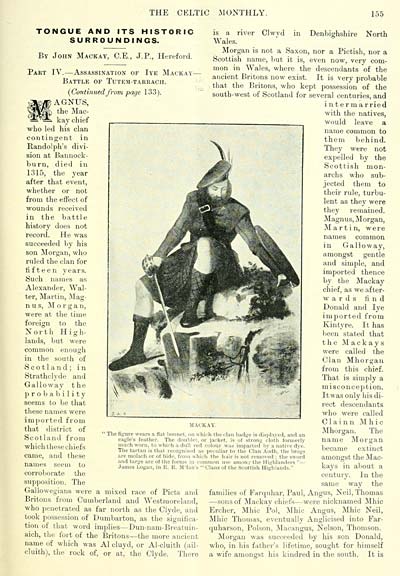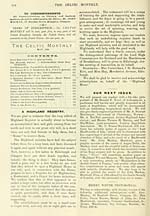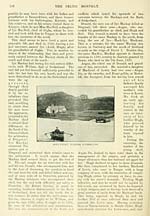Blair Collection > Celtic monthly > Volume 2, 1894
(177)
Download files
Complete book:
Individual page:
Thumbnail gallery: Grid view | List view

THE CELTIC MONTHLY.
155
TONGUE AND ITS HISTORIC
SURROUN DINGS.
By John Mackay, C.E., J.P., Hereford.
Part IV. — Assassination of Iye Mackav-
Battle of Tutem-tarrach.
{Continued from page 13.3).
^^tojp AGNUS,
^U^p the Mac-
■My^^ kay cliief
who led his clan
contingent in
Randolph's divi-
sion at Bannock-
burn, died in
1315, the year
after that event,
whether or not
from the effect of
wounds received
in the battle
history does not
record. He was
succeeded by his
son Morgan, who
ruled the clan for
fifteen years.
Such names as
Alexander, Wal-
ter, Martin, Mag-
nus, Morgan,
were at the time
foreign to the
North High-
lands, but were
common enough
in the south of
Scotland; in
Strathclyde and
Galloway the
probability
seems to be that
these names were
imported from
that district of
Scotland from
which these chiefs
came, and these
names seem to
corroborate the
supposition. The
is a river Clwyd in Denbighshire North
Wales.
Morgan is not a Saxon, nor a Pictish, nor a
Scottish name, but it is, even now, very com-
mon in Wales, where the descendants of the
ancient Britons now exist. It is very probable
that the Britons, who kept possession of the
south-west of Scotland for several centuries, and
i n ter m arried
with the natives,
would leave a
name common to
them behind.
They were not
expelled by the
Scottish mon-
archs who sub-
jected them to
their rule, turbu-
lent as they were
they remained.
Magnus, Morgan,
Martin, were
names common
in Galloway,
amongst gentle
and simple, and
imported thence
by the Mackay
chief, as we af ter-
wards find
Donald and lye
imported from
Kintyre. It has
been stated that
the Mackays
were called the
Clan Mhorgau
from this chief.
That is simply a
misconception.
It was only his di-
rect descendants
who were called
C 1 a i n n 51 h i c
Mhorgan. The
name Morgan
became extinct
amongst the Mac-
kays in about a
century. In the
same way the
MACKAY.
e fi^re weai's a flat bonnet, un w Inch the clan badge is displayed, and an
eagle's feather. The doublet, or jacket, is of strong cloth formerly
much worn, to which a dull red colour was imparted by a native dye.
The tartan is that reco^^nised as peculiar to the Clan Aodh, the brojrs
are molach or of hide, from which the hair is not removed ; the sword
and targe are of the forms in common use amonu' the Highlanders " —
James Logan, in R. R. Jl'Ian's " Clans of the Scottish Highlands."
Gallowegians were a mixed race of Picts and families of Farquhar, Paul, Angus, Neil, Thomas
Britons from Cumberland and Westmoreland, — sons of Mackay chiefs — were nicknamed Mhic
who penetrated as far north as the Clyde, and Ercher, Mine Pol, Mhic Angus, Mhic Neil,
took possession of Dumbarton, as the significa-
tion of that word implies — Dun-nam-Breatuin-
aich, the fort of the Britons— the more ancient
name of which was Al cluyd, or Al-cluith (ail-
cluith), the rock of, or at, the Clyde. There
Mhic Thomas, eventually Anglicised into Far-
quharson, Poison, Macangus, Nelson, Thomson.
Morgan was succeeded by his son Donald,
who, in his father's lifetime, sought for himself
a wife amongst his kindred in the south. It is
155
TONGUE AND ITS HISTORIC
SURROUN DINGS.
By John Mackay, C.E., J.P., Hereford.
Part IV. — Assassination of Iye Mackav-
Battle of Tutem-tarrach.
{Continued from page 13.3).
^^tojp AGNUS,
^U^p the Mac-
■My^^ kay cliief
who led his clan
contingent in
Randolph's divi-
sion at Bannock-
burn, died in
1315, the year
after that event,
whether or not
from the effect of
wounds received
in the battle
history does not
record. He was
succeeded by his
son Morgan, who
ruled the clan for
fifteen years.
Such names as
Alexander, Wal-
ter, Martin, Mag-
nus, Morgan,
were at the time
foreign to the
North High-
lands, but were
common enough
in the south of
Scotland; in
Strathclyde and
Galloway the
probability
seems to be that
these names were
imported from
that district of
Scotland from
which these chiefs
came, and these
names seem to
corroborate the
supposition. The
is a river Clwyd in Denbighshire North
Wales.
Morgan is not a Saxon, nor a Pictish, nor a
Scottish name, but it is, even now, very com-
mon in Wales, where the descendants of the
ancient Britons now exist. It is very probable
that the Britons, who kept possession of the
south-west of Scotland for several centuries, and
i n ter m arried
with the natives,
would leave a
name common to
them behind.
They were not
expelled by the
Scottish mon-
archs who sub-
jected them to
their rule, turbu-
lent as they were
they remained.
Magnus, Morgan,
Martin, were
names common
in Galloway,
amongst gentle
and simple, and
imported thence
by the Mackay
chief, as we af ter-
wards find
Donald and lye
imported from
Kintyre. It has
been stated that
the Mackays
were called the
Clan Mhorgau
from this chief.
That is simply a
misconception.
It was only his di-
rect descendants
who were called
C 1 a i n n 51 h i c
Mhorgan. The
name Morgan
became extinct
amongst the Mac-
kays in about a
century. In the
same way the
MACKAY.
e fi^re weai's a flat bonnet, un w Inch the clan badge is displayed, and an
eagle's feather. The doublet, or jacket, is of strong cloth formerly
much worn, to which a dull red colour was imparted by a native dye.
The tartan is that reco^^nised as peculiar to the Clan Aodh, the brojrs
are molach or of hide, from which the hair is not removed ; the sword
and targe are of the forms in common use amonu' the Highlanders " —
James Logan, in R. R. Jl'Ian's " Clans of the Scottish Highlands."
Gallowegians were a mixed race of Picts and families of Farquhar, Paul, Angus, Neil, Thomas
Britons from Cumberland and Westmoreland, — sons of Mackay chiefs — were nicknamed Mhic
who penetrated as far north as the Clyde, and Ercher, Mine Pol, Mhic Angus, Mhic Neil,
took possession of Dumbarton, as the significa-
tion of that word implies — Dun-nam-Breatuin-
aich, the fort of the Britons— the more ancient
name of which was Al cluyd, or Al-cluith (ail-
cluith), the rock of, or at, the Clyde. There
Mhic Thomas, eventually Anglicised into Far-
quharson, Poison, Macangus, Nelson, Thomson.
Morgan was succeeded by his son Donald,
who, in his father's lifetime, sought for himself
a wife amongst his kindred in the south. It is
Set display mode to: Large image | Transcription
Images and transcriptions on this page, including medium image downloads, may be used under the Creative Commons Attribution 4.0 International Licence unless otherwise stated. ![]()
| Early Gaelic Book Collections > Blair Collection > Celtic monthly > Volume 2, 1894 > (177) |
|---|
| Permanent URL | https://digital.nls.uk/75845847 |
|---|
| Shelfmark | Blair.55 |
|---|---|
| Additional NLS resources: | |
| Attribution and copyright: |
|
| Description | A selection of books from a collection of more than 500 titles, mostly on religious and literary topics. Also includes some material dealing with other Celtic languages and societies. Collection created towards the end of the 19th century by Lady Evelyn Stewart Murray. |
|---|
| Description | Selected items from five 'Special and Named Printed Collections'. Includes books in Gaelic and other Celtic languages, works about the Gaels, their languages, literature, culture and history. |
|---|

